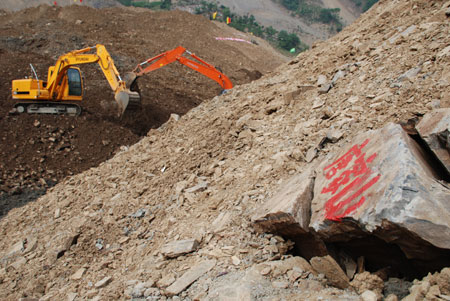Decision time near to drain quake-formed lake
(Xinhua)
Updated: 2008-06-04 19:22
Updated: 2008-06-04 19:22
CHENGDU - The plan to drain the Tangjiashan "quake lake" in southwest China's Sichuan Province is due to be implemented by Thursday or thereafter, with the trapped water volume having risen to 205.5 million cubic meters as of 5 p.m. Tuesday.
 An excavator digs division channels near the Tangjiashan lake in earthquake-hit Beichuan County, Southwest China's Sichuan Province June 2, 2008. [Xinhua]
|
The volume was 200.8 million cubic m at 8 a.m. Tuesday, according to the quake control and relief headquarters with the Ministry of Water Resources (MWR).
The water level has been moving higher. It stood at 737.33 meters at 5 p.m. Tuesday, up 0.7 meters from 8 a.m. on the same day, and 1.8 meters higher than at 8 a.m. Monday. The water level was just 2.37 meters from the lowest point of the blockage.
To prevent the quake-formed lake from breaching its barrier and endangering survivors downstream, more than 600 armed police and soldiers raced to complete a water diversion facility on Saturday night, digging a 475 meter channel in the barrier.
The timing of actually draining the lake, however, will be decided by water inflows from its upper reaches, said Liu Ning, MWR Chief Engineer.
According to Liu, the catchment area of the upper reaches covers 3,350 sq km. It is estimated that a 2 mm rainfall in that area will mean a rise of 1 meter in the water level before the quake lake barrier.
Weather experts consulted by the Sichuan Provincial Bureau of Meteorology on Tuesday predicted scattered thundershowers and two more rainy days on Thursday and Friday around Tangjiashan lake, with rainfall to peak on Thursday night and hit 20 mm.
According to weather records, rainfall for June, July and August over the Tangjiashan area stands at 140 mm, 360 mm and 330 mm, respectively. Rainfalls of such levels would pose a grave danger to the quake lake.
Here are some key statistics regarding the May 12 quake, Tangjiashan lake and efforts to avoid further emergencies:
Human toll -- The number of those killed was 69,122 as of Wednesday noon, the Information Office of the State Council said. Another 373,606 people were injured and 17,991 others remain missing, while 45.69 million people were affected by the disaster.
Tangjiashan lake -- One of 35 lakes formed after landslides triggered by the quake blocked rivers in the mountains. Tangjiashan lake, which sits on the Jianjiang River, a local waterway, is 3.2 km from the seat of the hard-hit Beichuan County. It is inaccessible by road and can only be reached by foot or air.
Evacuation plans -- There are three plans to move survivors if necessary. The target is zero deaths, according to Tan Li, Mianyang City Communist Party chief and also chief of its Quake Control and Relief Headquarters. In the first instance, 158,000 people will have to relocate if one-third of the lake breaches its banks. Actually, more than 250,000 people in Mianyang City have already been relocated.
Two other plans require the relocation of 1.2 million people if half the lake volume is released or 1.3 million if the barrier fully opens.
Water diversion channel -- A 475 meter channel was cut into the Tangjiashan lake barrier by 620 armed police and engineers over six days and nights. The cubical channel is 12 meters deep and 7 meters wide upstream and in the middle but becomes larger downstream. Most of the workers have already left the site. A dozen police stayed behind to monitor the situation.
|
||
|
||
|
|
|
|